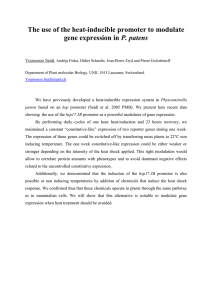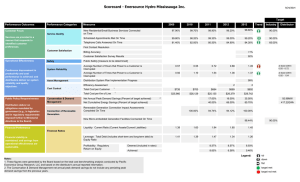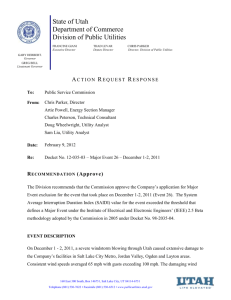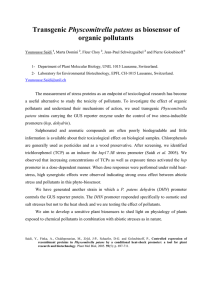A Reliability Improvement Roadmap Based on a Predictive Model
advertisement
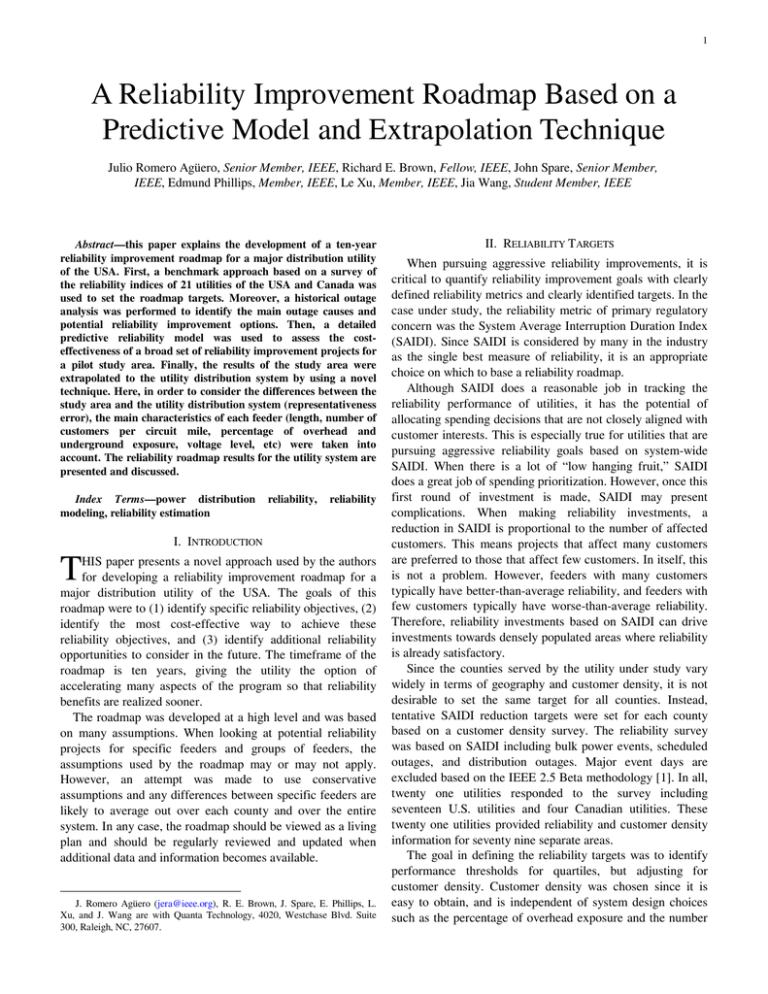
1 A Reliability Improvement Roadmap Based on a Predictive Model and Extrapolation Technique Julio Romero Agüero, Senior Member, IEEE, Richard E. Brown, Fellow, IEEE, John Spare, Senior Member, IEEE, Edmund Phillips, Member, IEEE, Le Xu, Member, IEEE, Jia Wang, Student Member, IEEE Abstract—this paper explains the development of a ten-year reliability improvement roadmap for a major distribution utility of the USA. First, a benchmark approach based on a survey of the reliability indices of 21 utilities of the USA and Canada was used to set the roadmap targets. Moreover, a historical outage analysis was performed to identify the main outage causes and potential reliability improvement options. Then, a detailed predictive reliability model was used to assess the costeffectiveness of a broad set of reliability improvement projects for a pilot study area. Finally, the results of the study area were extrapolated to the utility distribution system by using a novel technique. Here, in order to consider the differences between the study area and the utility distribution system (representativeness error), the main characteristics of each feeder (length, number of customers per circuit mile, percentage of overhead and underground exposure, voltage level, etc) were taken into account. The reliability roadmap results for the utility system are presented and discussed. Index Terms—power distribution modeling, reliability estimation T reliability, reliability I. INTRODUCTION HIS paper presents a novel approach used by the authors for developing a reliability improvement roadmap for a major distribution utility of the USA. The goals of this roadmap were to (1) identify specific reliability objectives, (2) identify the most cost-effective way to achieve these reliability objectives, and (3) identify additional reliability opportunities to consider in the future. The timeframe of the roadmap is ten years, giving the utility the option of accelerating many aspects of the program so that reliability benefits are realized sooner. The roadmap was developed at a high level and was based on many assumptions. When looking at potential reliability projects for specific feeders and groups of feeders, the assumptions used by the roadmap may or may not apply. However, an attempt was made to use conservative assumptions and any differences between specific feeders are likely to average out over each county and over the entire system. In any case, the roadmap should be viewed as a living plan and should be regularly reviewed and updated when additional data and information becomes available. J. Romero Agüero (jera@ieee.org), R. E. Brown, J. Spare, E. Phillips, L. Xu, and J. Wang are with Quanta Technology, 4020, Westchase Blvd. Suite 300, Raleigh, NC, 27607. II. RELIABILITY TARGETS When pursuing aggressive reliability improvements, it is critical to quantify reliability improvement goals with clearly defined reliability metrics and clearly identified targets. In the case under study, the reliability metric of primary regulatory concern was the System Average Interruption Duration Index (SAIDI). Since SAIDI is considered by many in the industry as the single best measure of reliability, it is an appropriate choice on which to base a reliability roadmap. Although SAIDI does a reasonable job in tracking the reliability performance of utilities, it has the potential of allocating spending decisions that are not closely aligned with customer interests. This is especially true for utilities that are pursuing aggressive reliability goals based on system-wide SAIDI. When there is a lot of “low hanging fruit,” SAIDI does a great job of spending prioritization. However, once this first round of investment is made, SAIDI may present complications. When making reliability investments, a reduction in SAIDI is proportional to the number of affected customers. This means projects that affect many customers are preferred to those that affect few customers. In itself, this is not a problem. However, feeders with many customers typically have better-than-average reliability, and feeders with few customers typically have worse-than-average reliability. Therefore, reliability investments based on SAIDI can drive investments towards densely populated areas where reliability is already satisfactory. Since the counties served by the utility under study vary widely in terms of geography and customer density, it is not desirable to set the same target for all counties. Instead, tentative SAIDI reduction targets were set for each county based on a customer density survey. The reliability survey was based on SAIDI including bulk power events, scheduled outages, and distribution outages. Major event days are excluded based on the IEEE 2.5 Beta methodology [1]. In all, twenty one utilities responded to the survey including seventeen U.S. utilities and four Canadian utilities. These twenty one utilities provided reliability and customer density information for seventy nine separate areas. The goal in defining the reliability targets was to identify performance thresholds for quartiles, but adjusting for customer density. Customer density was chosen since it is easy to obtain, and is independent of system design choices such as the percentage of overhead exposure and the number 2 of customers per circuit mile. To compute reliability versus customer density quartiles, the following steps were followed: 1. 2. 3. 4. Generate a scatter plot of SAIDI versus customer density. This scatter plot consists of 79 data points corresponding to the 79 areas identified in the benchmark surveys. Identify the 50% “average performance level” by identifying the best curve fit for the data points. Based on maximizing the coefficient of determination (R2), the best fit turns out to be logarithmic. Identify the 25% “third quartile” level by shifting the 50% curve up until 25% of data points are above curve. Identify 75% level by shifting 50% curve down until 25% of data points are below curve. Results of this process are shown in Figure 1. In each case, the lognormal curve fit does a good job of segmenting the data into halves. In terms of descriptive power, the industry SAIDI model has an R2 value of 0.2398. This means that customer density describes about 25% of the SAIDI data variation. The red dots in Figure 1 correspond to the counties served by the utility under study (the overall utility system is also shown). The utility counties values are based on the current outage reporting systems and processes. It is expected that computed SAIDI will increase after the utility implements a new Outage Management System (OMS). This would effectively shift all of the counties and system data points upwards on the graph. 300 C4 SAIDI (min/yr) 250 y = -19.037Ln(x) + 234.79 R2 = 0.2563 25% C5 50% 200 75% C7 C3 C2 150 C9 SYSTEM 100 C1 C8 C6 50 0 1 10 100 1,000 10,000 Customers per Square Mile Fig. 1 Reliability versus customer density quartiles Reliability targets are shown in Table I. Tentative SAIDI reduction targets have been set for each county based on the customer density benchmark survey. Reliability targets have been set equal to the borderline between 1st and 2nd quartile performance of Figure 1. Current reliability is based on average SAIDI values for 2005-2007. These targets are equivalent to shifting all of the red dots in Figure 1 down to the line labeled “75%”. An additional 25% reduction has been included to compensate for expected increases in SAIDI when the new OMS is deployed. As shown in Table I, the reliability roadmap goals are to reduce overall system SAIDI by 45.7%. This is an ambitious goal and will require a significant investment in the system. These targets are simply a result of the benchmark survey and only consider expected reliability differences associated with customer density. There may be other factors such as geography that allow for justification of reliability targets to be higher or lower than these target benchmark values. These factors may even make achieving some of the county targets cost prohibitive. Regardless, setting reliability targets based on industry-wide benchmark information is a good initial starting point from which to base the reliability roadmap. TABLE I County C1 C2 C3 C4 C5 C6 C7 C8 C9 System RELIABILITY TARGETS PER COUNTY AND SYSTEM IEEE SAIDI (min/yr) SAIDI Reduction '05-'07 2012 2017 2012 2017 Average Target Target 125.7 107.3 88.8 14.7% 29.3% 149.5 122.1 94.7 18.3% 36.7% 149.7 117.7 85.7 21.4% 42.7% 365.4 232.5 99.6 36.4% 72.7% 255.5 167.3 79.1 34.5% 69.0% 115.1 92.2 69.3 19.9% 39.8% 172.8 144.7 116.6 16.3% 32.5% 99.1 90.9 82.8 8.2% 16.4% 170.2 127.2 84.2 25.3% 50.5% 143.4 110.7 77.9 22.8% 45.7% III. HISTORICAL OUTAGE ANALYSIS Table II presents a summary of the main features of the utility system. Moreover, Figure 2 shows a summary of the historical SAIDI per county and system for 2003-2007. It can be concluded that the SAIDI values of most counties and the system have been progressively increasing during this period. TABLE II MAIN FEATURES OF UTILITY SYSTEM Exposure (%) Cust/ County sq.mi Overhead (OH) Underground (UG) C1 167 61.7% 38.3% C2 116 71.4% 28.6% C3 203 49.0% 51.0% C4 85 57.1% 42.9% C5 308 55.6% 44.4% C6 572 41.2% 58.8% C7 29 63.0% 37.0% C8 244 49.5% 50.5% C9 223 55.2% 44.8% System 264 51.8% 48.2% Table III and Figure 3 presents a summary of the utility’s non-storm outage history by cause for 2003-2007. According to these data, almost 50% of total outages were due to equipment failures. Excluding equipment failures, approximately 35% of total outages were due to birds and animals, trees on right-of-way, and trees off right-of-way. This was expected, given the characteristics of the utility service territory, where wooded areas are common, and the fact that, as shown in Table II, the utility system is 52% overhead, which makes it more prone to these types of faults. From this analysis, it was concluded that the most effective alternatives for improving the reliability of the utility system were those aimed at decreasing the frequency, and limiting the impact and extension of outages caused by faults on line 3 equipment, birds and animals, and trees on and off right-ofway. 500 450 400 350 study, a broad selection of approximately fifty projects was initially considered. After analyzing with the utility engineers the feasibility of implementing each alternative, and its compatibility with the utility practices, the following reliability improvement projects were included in the roadmap; here it is assumed that Distribution Automation (DA) devices have peer-to-peer communications capability: 300 250 200 150 100 50 0 C1 C2 C3 C4 2003 C5 2004 C6 2005 C7 2006 C8 C9 System 2007 Fig. 2 Historical SAIDI per county and system (min/yr) TABLE III NON-STORM OUTAGES BY CAUSE FOR 2003-2007 % of Description Total Total Equipment Failure (EF) 28,232 45.8% Birds and Animals (BA) 10,033 16.3% Tree on right-of-way (TO) 5,860 9.5% Tree off right-of-way (TF) 5,401 8.8% Schedule Outage (SO) 3,622 5.9% Dig Up (DU) 2,137 3.5% Accident - Other (AO) 1,683 2.7% Accident - Car/Pole (CP) 1,339 2.2% Unknown (UN) 1,314 2.1% Partial Outage (PO) 764 1.2% Electrical Overload (EO) 414 0.7% Lightning (LI) 270 0.4% Customer Request (CR) 234 0.4% Faulty Installation (FI) 119 0.2% Operating Error (OE) 79 0.1% Vandalism (VA) 59 0.1% Outside Disturbance (OD) 14 0.0% Normal Wore Out (NW) 4 0.0% Earthquake (EQ) 0 0.0% Total 61,578 100.0% 7000 6000 1. 2. 3. 4. 5. 6. 7. 8. 9. 10. 11. 12. 13. Installing new manual three-phase reclosers Installing new three-phase DA reclosers Installing new lateral fuses Using fuse saving during storms Installing new manual three-phase switches Installing new three-phase DA switches (overhead) Installing new three-phase DA switches (underground) Implementing an inspection plan for feeders Implementing an inspection plan for reclosers Implementing an inspection plan for switches Installing animal guards on feeders Installing Faulted Circuit Indicators (FCI) on feeders Installing tree wire / spacer cable on selected locations Moreover, the following projects were being implemented by the utility. Therefore, their reliability impact was also considered in the roadmap: 1. 2. 3. 4. 5. Performing a system-wide protection coordination study Providing all substations with SCADA Installing a Mobile Workforce Management System Danger tree removal Off right-of-way tree removal Finally, some projects were selected for future consideration (e.g., infrared inspection of overhead feeders), and others were analyzed and not deemed cost-effective for inclusion in the reliability roadmap (e.g., implementing Fault Circuit Indicators with SCADA). Similarly, the utility requested not to consider a small group of projects, given that they were incompatible with its practices (e.g., fuse saving during normal operation). 5000 V. RELIABILITY ASSESSMENT 4000 A. Pilot Area Model A predictive reliability model for a pilot area of the utility service territory was developed by using SynerGEE® [1]. This area belongs to county C6 of Tables I and II, therefore it is assumed that its SAIDI reduction target is also 39.8%. This area serves about 36,000 customers and consists of 30 feeders (12.5 kV). This model is able to quantify the benefits of potential reliability improvement projects – both individual projects and sets of projects. The model was used to compute cost versus reliability curves for the selected reliability improvement projects. It was also used to develop an “integrated solution” consisting of a coordinated mix of projects. The combination of these two sets of results is the basis for benefit predictions for the system-wide reliability 3000 2000 1000 0 AO BA CP CR DU EF EO EQ FI 2003 2004 LI NW OD OE PO SO TF TO UN VA 2005 2006 2007 Fig. 3 Total system outages per cause IV. RELIABILITY IMPROVEMENT PROJECTS When attempting to achieve significant improvements in reliability, it is important to consider as many possible reliability improvement projects as possible. As part of this 4 TABLE IV FAILURE RATES AND MTTR OF COMPONENTS Failure rate MTTR Equipment (faults/yr) (hours) Fuse 0.009 2 Switch 0.014 4 Sectionalizer 0.015 4 Recloser 0.015 4 Transformer 0.010 5 Breaker 0.010 12 implementation of each project in the pilot study area was calculated by using the predictive reliability model. When the SAIDI reductions due to individual projects were added up without considering any project interactions, a total SAIDI reduction of approximately 65% (with a total cost of $ 4.7 million) was achieved; this is shown in Figure 4. The results obtained during this stage were used as a reference for estimating the expected SAIDI reduction due to the implementation of the same projects in the overall utility system. For instance, Table V shows the SAIDI reduction calculated by the predictive reliability model due to “installing new three-phase DA reclosers” in the pilot study area. 100% SAIDI After (%) roadmap. Typically cost-effectiveness is measured by the ratio of reduction in customer interruption minutes to cost (CMI/$). The characteristics of the pilot area are significantly different than the characteristics of certain counties in the utility service territory. Therefore, assumptions were made to account for these differences when developing the roadmap. The predictive model was calibrated to reflect the historical reliability of the pilot study area. The calibration was done by iteratively modifying the failure and Mean Time to Repair (MTTR) of overhead and underground distribution lines in the model, until the reliability indices computed by SynerGEE® matched the calibration targets. The failure rates of sustained faults and MTTR of the distribution equipment (fuses, reclosers, switches, etc) are kept fixed during the calibration; Table IV shows the values used in this study. 80% 60% 40% 20% The reliability targets used during the calibration were the five-year average SAIDI and SAIFI of each feeder in the pilot study area. These indices were calculated by using the IEEE 2.5 Beta method for storm exclusion. Moreover, the following assumptions were made during the calibration, these assumptions are based on the analysis of the utility historical outage data and accepted industry practices [2] – [7]: 1. 2. 3. 4. 5. 6. 7. 8. 9. For sustained faults, the failure rates of overhead lines are 2.5 times that of underground lines For overhead lines, the failure rates of momentary faults are 2 times that of sustained faults For underground lines, the failure rates of momentary faults are equal to zero Mean time to repair of underground lines is 2 times that of overhead lines Momentary events have duration less than 5 minutes Reclosing is allowed on all circuit breakers All automatic switches and automatic transfer switches have an operation time of 1 minute For distribution equipment, failure rates of momentary faults are equal to zero 75% of all faults are single-phase B. Pilot Area Reliability Assessment The impact of the selected reliability improvement projects on the pilot area were assessed by using the predictive model developed in SynerGEE®. This assessment was carried out in two stages: individual project analysis and integrated solution analysis. In the first stage, the SAIDI reduction due to the individual 0 1 2 3 4 5 Cost (M$) Fig. 4 Total system outages per cause TABLE V Feeder 1 2 3 4 5 6 7 8 9 10 11 12 13 14 15 16 17 18 19 20 21 22 23 24 25 26 27 28 29 30 Pilot Area SAIDI REDUCTION DUE TO DA RECLOSERS SAIDI Before (min) After (min) Reduction (%) 151.41 135.27 11 159.10 130.75 18 218.38 152.21 30 148.71 89.58 40 161.36 140.31 13 144.32 124.32 14 91.74 64.95 29 105.33 81.11 23 131.72 120.83 8 62.48 50.71 19 84.05 67.34 20 88.72 82.30 7 81.34 66.72 18 113.00 85.92 24 95.16 89.17 6 97.60 89.45 8 91.01 84.75 7 108.41 94.78 13 129.08 120.85 6 20.32 16.56 19 22.76 20.11 12 137.32 126.34 8 25.71 21.82 15 76.58 67.64 12 112.29 110.68 1 40.18 38.22 5 41.75 7.23 98.24 7.4 94.82 81.56 14 These results show that by installing 32 reclosers in 5 overhead lines an overall SAIDI reduction of 14% was achieved (feeders 27-30 are mostly underground). For feeders where only one DA recloser was installed, an average SAIDI reduction of 12.1% was achieved. Likewise, for feeders with two DA reclosers, the average SAIDI reduction was 23.9%. Based on these results, an average SAIDI reduction of 10% per new DA recloser added was assumed to extrapolate the project benefits to the overall utility system. Moreover, the cost-effectiveness of implementing each project was also calculated. The cost-effectiveness is usually estimated as the ratio of the reduction of Customer-Minutes of Interruption (CMI reduction) to dollars ($). An accepted industry practice is that the most efficient alternatives for improving reliability should have a cost-effectiveness greater than 0.5 CMI reduction/$ (or equivalently, a costeffectiveness less than 2.0 $/CMI reduction). Here it is important to highlight that the SAIDI reduction is proportional to the CMI reduction. The cost-effectiveness provides a guideline for selecting and prioritizing the implementation of the most efficient projects, i.e., those that would give the utility “more bang for the buck”. For instance, cost-effectiveness of 0.5 CMI reduction/$ implies that for each dollar invested, a reduction of 0.5 CMI is achieved. Figure 5 shows a plot of the cost-effectiveness of “installing new three-phase DA reclosers” in the pilot study area. CMI reduction/$ 1.5 1.0 0.5 0.0 1 2 3 4 5 6 7 8 9 10 11 12 13 14 15 16 17 18 19 20 21 22 23 24 25 26 Feeders Fig. 5 Cost-effectiveness (CMI reduction/$) of installing new three-phase reclosers” in the pilot study area In the second stage, the SAIDI reduction due to the joint implementation of all projects was calculated. Table VI shows the reliability improvements obtained by implementing the “integrated solution” in the pilot study area. The SAIDI reduction values of Table VI were calculated by comparing the base case (current situation), with the reliability improvements due to the “integrated solution”. Here it is important to highlight that the total SAIDI reduction of 44.2% exceeds the target value of 39.8% defined for the pilot study area, which is part of county C6. The total cost of implementing the integrated solution was $4.1 million. When multiple reliability projects are implemented together, the benefits of the integrated solution are typically lower than the sum of the project benefits considered separately. For the pilot study area, this difference is approximately 21%. This is due to the project interaction effects. For example, when considered separately, a midpoint recloser might reduce feeder SAIDI by 20% and increased tree trimming on the main trunk might also reduce SAIDI by 20%. However, the benefits of both of these projects both being done is less than 40%. This is because a reduction in tree trimming will result in fewer outages and therefore will result in fewer benefits for the new recloser. Similarly, the new recloser will more effectively isolate faults and will therefore result in fewer benefits for increased tree trimming. This difference was taken into account for extrapolating the reliability benefits of individual projects to the overall utility system. TABLE VI SAIDI REDUCTION DUE TO INTEGRATED SOLUTION SAIDI Feeder Before (min) After (min) Reduction (%) 1 151.41 77.28 49 2 159.10 74.40 53 3 203.51 83.16 59 4 148.71 55.80 62 5 161.36 78.14 52 6 144.32 74.38 48 7 91.74 47.80 48 8 105.53 47.47 55 9 131.72 71.25 46 10 62.48 25.06 60 11 84.05 42.47 49 12 88.72 63.17 29 13 81.34 48.12 41 14 113.00 60.09 47 15 94.58 64.38 32 16 97.60 74.08 24 17 91.01 53.83 41 18 108.41 55.11 49 19 129.08 89.65 31 20 20.32 9.80 52 21 22.95 13.65 41 22 137.32 78.54 43 23 25.71 13.46 48 24 76.58 36.20 53 25 112.29 87.44 22 26 40.18 27.88 31 27 41.75 32.97 21 28 7.23 6.95 4 29 98.24 78.44 20 30 7.40 7.23 2 Pilot Area 94.82 52.91 44 VI. EXTRAPOLATION The analysis that was performed for each of the reliability options in section V provided detailed costs and benefits for the pilot area. The pilot area contained a variety of different feeder configurations upon which to base potential reliability benefits elsewhere on the utility system due to the implementation of the reliability improvement projects. A strategy was developed to take the pilot area results and extrapolate them to achieve expected benefits and costs for the whole system. The goals of the extrapolation strategy are: 6 2. 3. Recommend a reliability roadmap for the whole utility system that would provide first quartile reliability performance with a 10 year investment program Identify a portfolio of reliability options that would achieve these results most cost-effectively Identify the level of investment that would be required in each county to achieve these results The strategy was based on evaluating the features and characteristics of the feeders in the pilot area and determining what features and parameters can be used to identity corresponding feeders elsewhere in the utility system. Table VII shows a summary of the features that were considered for performing this extrapolation. These same features were also available for each county of the utility service territory. TABLE VII FEATURES USED FOR THE EXTRAPOLATION Pilot Area System Reliability SAIDI average 94.8 143.4 SAIDI Target (min) 56.9 77.9 SAIDI Target (%) 40% 46% System Data Cust/ sq.mi. 263.5 Cust/ Feeder 1215.9 944.7 Cust/ Ckt-mi 64.9 53.0 Fdr/ Sub. 3.3 4.0 % OH 36.2% 51.4% % UG 63.8% 48.6% Miles/ Fdr 18.7 17.9 Based on pilot area results, a rule-based system was used for estimating the reliability benefits of implementing each project for the overall utility system, i.e., for extrapolating the pilot area results to the utility system. In all cases, conservative assumptions were made. Examples of the rules used for the extrapolation are: Project: Installing new three-phase DA reclosers • Description: Place new reclosers in new locations on new Class 2 poles, which are assumed to replace an existing pole. The DA reclosers are set for “fuse clearing mode” and are outfitted with communications so that they can quickly be opened and closed after a fault occurs. • Cost: An assumed cost of $38,400 per location is used; this cost is based on the utility cost estimations plus the cost of communications equipment. • Amount: Installing 1 new unit for feeders with overhead exposure between 10-25 miles and two units for feeders with overhead exposure between 25-35 miles. Existing reclosers are subtracted from this amount. For example, an existing feeder with 30 miles of OH exposure and an existing recloser is assigned one new unit. • Benefit: SAIDI reduction is assumed to be 10% per device added, which is based on the predictive model results for the pilot study area and is a bit conservative. In the model, SAIDI reduction for feeders with 1 new recloser was an average of 12.1%, and SAIDI reduction for feeders with 2 new reclosers was an average of 23.9%. Project: Installing new three-phase DA switches (underground) • Description: Installing new pad-mounded DA switches in either new locations or in locations with existing manual pad-mounted switchgear. The DA switches are outfitted with communications so that they can quickly be opened and closed after a fault occurs. • Cost: The assumed cost of $77,400 per location is based on the utility costs estimations plus the cost of communications equipment. • Amount: Installing 1.5 new units to the 100 circuits with most underground exposure. This implies a normallyclosed switch plus a normally-open tie switch that is shared between two neighbor feeders. • Benefit: SAIDI reduction is assumed to be 15% per feeder affected, which is based on the predictive model results for the pilot study area, which showed a 15% reduction. Typically, extrapolation was done for each feeder based on specific feeder characteristics. Feeder results for each county were then aggregated to show county-level roadmap estimates. For each county, a cost-to-benefit ratio ($/CMI) was computed for each of the reliability roadmap options. For the 9 counties and 13 roadmap reliability options, this generated 117 data points. Each data point represents one reliability option for a specific county. When all of these data points are sorted by $/CMI they represent an order for implementation that would permit the most cost-effective results to be achieved up front. These CMI reduction numbers can then be translated into SAIDI values. Figure 5 is a plot showing the cumulative CMI reduction and the cumulative dollar spend as projects are implemented in that order. VII. TEN-YEAR ROADMAP This section presents the ten year roadmap that resulted from the extrapolation effort documented in the previous section. Benefits are shown as reductions in customer minutes of interruption (CMI), which is proportional to SAIDI reduction. These benefits are based upon the pilot study results, extrapolation rule base, and extrapolation results. 140 130 120 110 100 SAIDI (min/yr) 1. 90 80 70 60 50 40 30 20 10 0 0 10 20 30 40 50 60 70 Reliabilty Roadmap Spending ($M) Fig. 5 SAIDI reduction for the overall utility system 80 90 7 The integrated solution of the pilot study area was used to account for the effects of project interactions. The cost of the integrated solution was $4.1 million and resulted in a SAIDI reduction of 44%. As shown in Fig.4, when spending the same $4.1 million based on non-integrated analyses, the SAIDI reduction is 65%. This is a difference of 21%. However, the benefits of the projects that reduce failure rates and repair times were determined by examining their impact on the integrated solution, and therefore already include project interactions. As such, aggregated CMI benefits from roadmap projects are reduced by 15% to account for project interactions. Roadmap costs are summarized in Table VIII. This includes the total estimated costs for each roadmap project. It also includes incremental cost adjustments for projects that are already being implemented by the utility (in this case, all are related to storm hardening activities). TABLE VIII RELIABILITY IMPROVEMENT PROJECTS IN ROADMAP Roadmap Projects Cost ($1000s) New 3-phase DA reclosers 7,910 New 3-phase reclosers 3,266 New 3-phase manual switches 20,372 New UG DA switches 11,610 New OH DA switches 10,061 Animal guards 5,630 Spacer cable 4,530 New lateral fuses 5,480 Faulted Circuit Indicators 5,352 OH feeder inspections 6,833 Recloser inspections 563 Fuse saving during storms 206 UG switch inspections 913 OH DA switch inspections 223 UG DA switch inspections 128 Projects in other budgets Circuit segmentation -27,864 Critical pole hardening 30,341 Pole test-and-treat program 42,954 Danger tree removal 10,000 Off right-of-way tree removal 20,000 Cost of Roadmap Projects 83,077 Adjustments for other budgets 75,431 Net Cost ($1000s) 158,508 TABLE IX RELIABILITY BENEFITS OF ROADMAP PER COUNTY SAIDI (min) SAIDI reduction SAIDI Target (%) Before After (min) (%) C1 125.7 54.2 71.5 56.9% 29.3% C2 149.5 46.9 102.6 68.6% 36.7% C3 149.7 65.2 84.5 56.4% 42.7% C4 365.4 195.1 170.3 46.6% 72.7% C5 255.5 137.4 118.1 46.2% 69.0% C6 115.1 65.9 49.2 42.8% 39.8% C7 172.8 31.9 141 81.6% 32.5% C8 99.1 41.6 57.5 58.1% 16.4% C9 170.2 54.1 116.1 68.2% 50.5% System 143.4 72.1 71.3 49.70% 45.70% Summary The cost of the reliability roadmap is $83,077,000 over ten years. This roadmap also calls for an increase in the utility storm hardening budget of $45,431,000 (driven mostly by a wood pole test-and-treat program). This results in a net incremental spending increase of $128,508,000, or about $12.9 million per year over ten years. These numbers are not allocated to any specific year and are not adjusted to include inflation. Roadmap benefits are summarized in Tables IX and X. This includes estimated CMI reduction by project and by county. It also provides an overall CMI reduction/$ score for each project. Total estimated system SAIDI reduction is 45.7%, which is equal to the desired reduction target. SAIDI reduction by county varies somewhat when compared to targets. County C6 match targets closely, which is expected since the pilot area (from which assumptions are based) belongs to this county. The only counties that did not reach their targets are C4 and C5. However, these two counties started out with very high SAIDI values and the actual SAIDI minutes reduced in these counties is two to three times higher than the system average. When the actual roadmap is implemented, spending can be prioritized and shifted between counties to achieve desired balance. TABLE X RELIABILITY BENEFITS OF ROADMAP FOR THE UTILITY SYSTEM Roadmap Projects CMI Reduction CMI/$ New 3-phase DA reclosers 3,522,007 0.45 New 3-phase reclosers 3,827,569 1.17 New 3-phase manual switches 20,350,325 1.00 New UG DA switches 5,273,644 0.45 New OH DA switches 4,511,610 0.45 Animal guards 5,489,384 0.98 Spacer cable 1,249,157 0.28 New lateral fuses 6,507,881 1.19 Faulted Circuit Indicators 6,043,005 1.13 OH feeder inspections 11,241,817 1.65 Recloser inspections 214,384 0.38 Fuse saving during storms 352,201 1.71 UG switch inspections 2,032,509 2.23 Projects in Other Budgets Substation automation 295,844 --Improved fuse coordination 11,028,484 --Mobile workforce mgmt. 2,115,052 --Danger tree removal 3,679,978 Off right-of-way tree removal 3,679,978 Total CMI Red. (Roadmap) 70,615,492 Total CMI Red. (other budgets) 20,799,336 Gross CMI Red. 91,414,827 CMI Reduction 15% discount 77,702,603 SAIDI Before (min) 143.4 SAIDI After (min) 72.1 SAIDI Reduction (min) 71.3 % SAIDI Reduction 49.7% % SAIDI Target Reduction 45.7% VIII. CONCLUSIONS This paper has presented a novel methodology for developing a reliability roadmap. The methodology has been used for a real distribution system of a major utility of the USA, aiming at reducing overall system SAIDI by 50% while making significant improvements in all counties of the utility service territory. The cost of the reliability roadmap is estimated to be $83,077,000 over ten years. This roadmap also calls for an increase in the utility storm hardening budget of $75,431,000 (driven mostly by a wood pole test-and-treat program). This results in a net incremental spending increase of $158,508,000, or about $15.9 million per year over ten years. These numbers are not allocated to any specific year and are not adjusted to include inflation. 8 The reliability roadmap is aggressive, calls for a variety or reliability improvement initiatives, and requires a substantial investment. The underlying assumption was that this roadmap would be implemented over ten years. However, the roadmap can be accelerated or slowed down as desired, with costs and benefits adjusting accordingly. In addition, the roadmap provides costs and benefits of each reliability improvement category separately and for each county. This allows the utility to select parts of the roadmap for a more targeted yet cost effective approach if desired. It is important to highlight that this roadmap is based on a high level analysis and required many assumptions. Therefore, in order to obtain more accurate reliability improvement estimates it is recommended to base specific reliability projects on predictive reliability models similar to the pilot study analysis presented in Section IV. If this approach is pursued, the utility has a good possibility of exceeding the roadmap reliability improvement targets and significantly improving reliability for its customers in a defendable and cost justified manner. IX. REFERENCES [1] [2] [3] [4] [5] [6] [7] SynerGEE® Electric http://www.advanticagroup.com/ R.E. Brown, Electric Power Distribution Reliability, Marcel Dekker, Inc, 2002 H.L. Willis, Power Distribution Planning Reference Book, Second Edition, Revised and Expanded, Marcel Dekker, 2004 J.J. Burke, Power Distribution Engineering, CRC Press, 1994 T.A. Short, Electric Power Distribution Handbook, CRC Press, 2003 R.E. Brown, “Distribution reliability modeling at Commonwealth Edison”, 2001 IEEE Transmission and Distribution Conference and Exposition, Vol. 2, pp. 917 – 921, Nov. 2001 D.P. Ross, L.A.A. Freeman, R.E. Brown, “Overcoming data problems in predictive reliability distribution modeling”, 2001 IEEE Transmission and Distribution Conference and Exposition, Vol. 2, pp. 742 – 748, Nov. 2001 X. BIOGRAPHIES Julio Romero Agüero (S’00, M’05, SM’06) is former National Energy Commissioner of Honduras. Since 2007, he has been an Advisor for Quanta Technology, Raleigh, NC. He received the Electrical Engineer degree in 1996, from Universidad Nacional Autónoma de Honduras (UNAH) and the Ph.D. degree in Electrical Engineering in 2005 (with honors) from Universidad Nacional de San Juan (UNSJ), Argentina. His areas of expertise include reliability, planning, regulation, operation, maintenance and analysis of power distribution systems. Richard E. Brown (F’07) is the Vice President of Operations for Quanta Technology. He has published more than 80 technical papers related to distribution system reliability and asset management; is a regular instructor on these topics; is author of the book Electric Power Distribution Reliability; and is a registered professional engineer. He is an IEEE Fellow. Dr. Brown earned his BSEE, MSEE, and PhD from the University of Washington in Seattle, and his MBA from the University of North Carolina at Chapel Hill. John Spare (S’66, M’75, SM’81) is a Principal Advisor for Quanta Technology, Raleigh, NC. He has over 35 years of experience in power distribution planning, reliability engineering, and underground systems. Dr. Spare has a BSEE from Carnegie Mellon and MSEE and PhD-EE degrees from the University of Pennsylvania. He is registered professional engineer in Pennsylvania. Edmund Phillips (S’01-M’02) is with Quanta Technology, Raleigh, NC where he specializes in distribution system planning. He has a BSEE and MSEE degrees from Florida International University, where he was Engineering Student of the Year in 2000. Prior to joining Quanta, Mr. Phillips was with Jamaica Power Company and Dayton Power and Light. Le Xu (S’01-M’07) received the B.Eng. degree in automation from Tsinghua University, Beijing, China, in 2001 and the M.S and Ph.D. degree in electrical engineering from North Carolina State University, Raleigh, in 2003 and 2006, respectively. Upon completion of the Ph.D. degree, he joined Quanta Technology, Raleigh, NC. He has been involved in various projects in severe weather system performance analysis, power distribution reliability, and spatial load forecasting. Jia Wang (S’07) is a Senior Engineer for Quanta Technology, Raleigh, NC where she specializes in distribution reliability analysis and load forecasting. She also has a broad background in control and automation, optimization, and machine learning. She received her MESS from NCSU in 2008, and her B.Eng. from Tsinghua University, Beijing in 2006.

